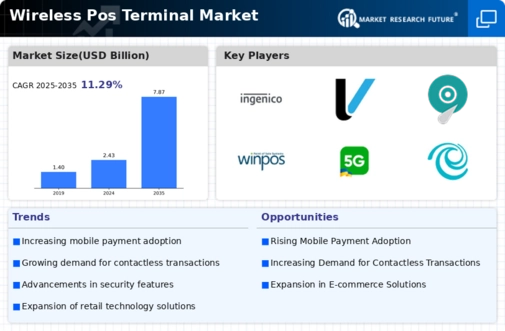Market Analysis
In-depth Analysis of Wireless Pos Terminal Market Industry Landscape
The Wireless POS Terminal market is driven by dynamic factors that shape its overall market dynamics. One of the key drivers is the rapid advancement in technology. As technological innovations continue to unfold, wireless POS terminals are evolving to offer more sophisticated features and functionalities. This constant technological progress fuels the market's growth, enabling businesses to access cutting-edge solutions for payment processing, inventory management, and customer interactions.
Consumer behavior and preferences also play a pivotal role in the market dynamics of wireless POS terminals. The increasing demand for seamless and convenient payment options, coupled with the rise of contactless transactions, drives businesses to adopt wireless solutions that align with these preferences. As consumers seek faster and more efficient payment methods, businesses in various industries are compelled to invest in wireless POS terminals to meet these changing expectations.
Moreover, the regulatory landscape significantly influences the market dynamics. Stringent security standards and compliance requirements in the payment industry propel businesses to adopt wireless POS terminals that adhere to these regulations. The need for secure and compliant payment processing solutions drives continuous innovation in the market, ensuring that wireless POS terminals meet the evolving standards set by regulatory bodies.
The global economic landscape also impacts the wireless POS terminal market dynamics. Economic fluctuations, market uncertainties, and geopolitical events can influence the purchasing power of businesses, affecting their decisions to invest in technology, including wireless POS solutions. Economic stability fosters confidence among businesses, encouraging them to adopt wireless POS terminals to improve operational efficiency and enhance the overall customer experience.
Competitive forces within the market contribute to its dynamics as well. The presence of numerous vendors, each vying for a significant market share, results in intense competition. Companies engage in strategies such as pricing wars, product differentiation, and aggressive marketing to gain a competitive edge. This competition not only drives innovation but also influences the overall pricing structure of wireless POS terminals, making them more accessible to a broader range of businesses.
Additionally, the growth of e-commerce and the digitalization of retail processes are transforming the market dynamics of wireless POS terminals. As businesses embrace online sales channels and omnichannel strategies, the demand for integrated and flexible POS solutions increases. Wireless POS terminals that seamlessly integrate with e-commerce platforms, inventory management systems, and other business tools become crucial for providing a unified and streamlined retail experience.
Furthermore, the increasing prevalence of data breaches and cyber threats shapes the market dynamics by elevating the importance of security features in wireless POS terminals. Businesses prioritize solutions that offer robust security measures such as encryption, tokenization, and authentication protocols to safeguard sensitive customer and financial data. The market responds by continuously enhancing security features to address the growing concerns surrounding data breaches.
The COVID-19 pandemic has also exerted a significant influence on the wireless POS terminal market dynamics. The emphasis on contactless transactions to minimize physical contact has accelerated the adoption of wireless POS solutions. Businesses, particularly in sectors like hospitality and retail, have increasingly turned to wireless POS terminals to facilitate safer and more hygienic transactions, further driving market growth.








Leave a Comment